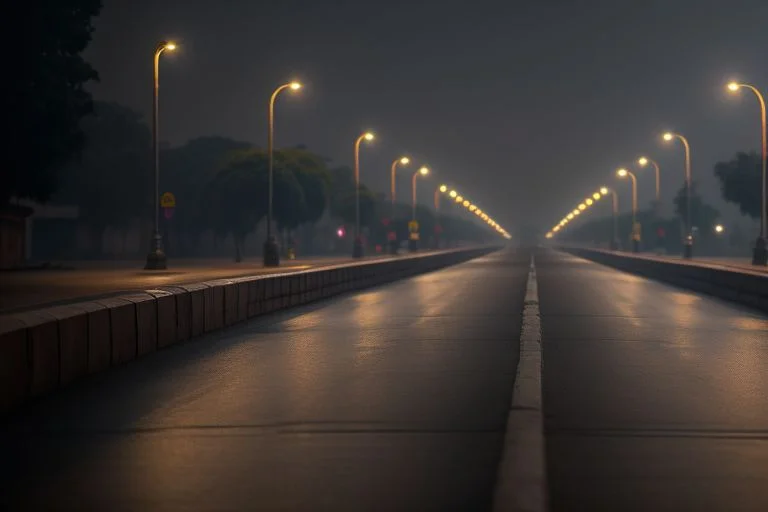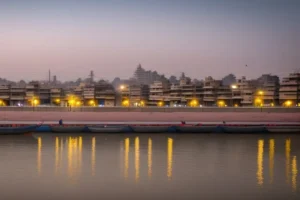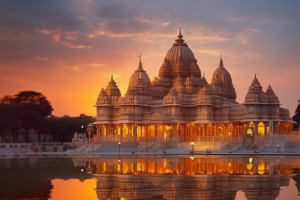Often overshadowed by the bustling metropolises of India, a cluster of towns in western Uttar Pradesh Aligarh, Etah, Hathras & Kasganj holds a treasure trove of historical significance, natural beauty, and cultural experiences waiting to be explored. Aligarh, Etah, Hathras, and Kasganj, bathed in the gentle caress of the Yamuna river, offer a glimpse into a bygone era while pulsating with a vibrant local life. So, ditch the usual tourist trail and embark on a journey to discover these hidden gems.
Table of Contents
Aligarh: A Legacy of Forts and Education
Aligarh, most famous for the Aligarh Muslim University, boasts a rich tapestry woven with Mughal influences and the freedom struggle.
- Aligarh Fort: Standing tall since the 16th century, the fort served as the headquarters of Raja Man Singh Tomar. Its imposing gateways, bastions, and a mosque within its walls narrate tales of battles fought and empires built.
- Jama Masjid: This magnificent 17th-century mosque is a classic example of Mughal architecture, with soaring minarets and intricately carved sandstone walls.
- Sir Syed Ahmed Khan’s Tomb: Pay homage to the visionary educationist who established Aligarh Muslim University at the serene tomb of Sir Syed Ahmed Khan.
Etah: Where History Whispers
Etah, steeped in mythology and history, offers a glimpse into ancient India.
- Raja Bhoj ka Bawa: Legend has it that this ancient well, built by Raja Bhoj, never dries up, a testament to the bygone era’s engineering marvels.
- Jalesar Fort: Standing on the banks of the Yamuna, the crumbling Jalesar Fort whispers stories of Mughal battles and Rajput valor.
- Saini Dham Mandir: This intricately carved temple complex dedicated to Lord Shiva is a haven for spiritual seekers.
Hathras: A Land of Religious Harmony
Hathras, known for its religious sites and traditional crafts, showcases the peaceful coexistence of diverse faiths.
- Chandrahaas Temple: This ancient Shiva temple, said to be built by Pandavas during their exile, holds immense religious significance.
- Jama Masjid: A beautiful mosque with a towering central dome and intricate stonework reflects the rich Islamic heritage of Hathras.
- Hathras Glass Industry: Explore the age-old art of glassblowing practiced for generations, and witness the creation of exquisite glass bangles and decorative items.
Kasganj: A Birdwatcher’s Paradise
Kasganj, blessed with natural beauty and historical charm, is a perfect getaway for nature enthusiasts and history buffs.
- Shekha Bird Sanctuary: A haven for birdwatchers, this sanctuary is home to over 250 species of resident and migratory birds, making it a paradise for ornithologists and nature lovers.
- Kasganj Fort: This 16th-century fort, now in ruins, offers panoramic views of the city and a glimpse into its glorious past.
- Ahinsa Dharm Chakra Statue: This colossal statue of the Dharma Chakra, a symbol of non-violence, stands as a testament to India’s rich heritage of peace and tolerance.
Beyond the Monuments: Unveiling Local Experiences
- Savor the Flavors: Immerse yourself in the local culinary scene, indulging in delicacies like Aligarh’s mutton korma, Etah’s petha (a sweet dish made from pumpkin), Hathras’ kachori (a fried snack), and Kasganj’s imarti (a sweet fried pastry).
- Embrace the Colors: Witness the vibrant culture with folk performances, colorful bazaars selling traditional handicrafts, and the warm hospitality of the locals.
- Explore Nature’s Bounty: Take a serene boat ride on the Yamuna river or explore the lush green countryside surrounding these towns.
FAQs for the Curious Traveler
Best Time to Visit:
The winter months (October to March) offer pleasant weather for sightseeing.
How to Get There:
Aligarh, Etah, Hathras, and Kasganj are well-connected by road and rail networks to major cities in India.
Accommodation:
A range of hotels, guesthouses, and budget accommodations cater to different travel styles.
Local Transport:
Rickshaws, taxis, and auto-rickshaws are readily available for getting around.
Safety:
These towns are generally safe for tourists. However, practicing basic precautions is recommended.
Currency Exchange:
Major banks and hotels offer currency exchange facilities.
Language:
Hindi is the primary language, but English is understood in most tourist areas.
Local Etiquette:
Dress modestly, especially when visiting religious sites. Respect local customs and traditions





